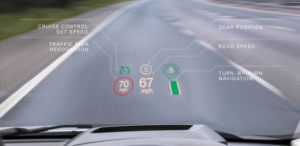Last year Jaguar Land Rover announced that they are offering a newly-developed HUD on the new Land Rover Evoque. While HUD’s are becoming almost a must for luxury vehicles, this particular announcement is a little different as the specifics of the display technology are kind of a first for this technology.
While HUDs today are mostly using LCD-based projectors, Jaguar Land Rover is using a ‘holographic Laser’ projector. The system offers “superior colour saturation, brightness and contrast compared to rival systems, and all in a small, lightweight package. The innovative laser system is more robust against issues such as “washout” – the effect that the glare from sunlight has on inferior LED-based systems.”
Source: University of Cambridge
In a new press release from Cambridge University, we are now learning a little bit more about this holographic projection system. The technology has been in development for ten years at Cambridge University and was further developed in conjunction with Alps Electric. What was not known is that this relationship involved a third company, Two Trees Photonics (2TP) that includes the researchers from Cambridge University in conjunction with funding from Alps.
This solution is based on a “phase only hologram” that provides the cited improved image quality, but functions quite differently from other projection systems. Do not expect any real holograms floating in front of the car; everything is still pretty much 2D and only visible only to the driver. The phase only design allows for a much decreased processing requirements but eliminates the amplitude information from the reconstructed wavefront. Since the HUD is typically fighting with contrast against the real world image anyway, this is not a particular important loss for a HUD information display.
It seems, the recent press release about a product that has been on the market for over a year already, could be triggered by different events. One possible explanation is that the Land Rover exclusive is running out and Two Tree Photonics can now solicit other customers with their technology. As they state, they are now ready to address and support a larger customer base and HUDs are one identified target application for their technology.
If you are interested in a more detailed discussion of the technology you can find some background information in ‘Fundamentals of phase-only liquid crystal on silicon (LCOS) devices’, published by Zichen Zhang, Zheng You and Daping Chu (Tsinghua University, Beijing, China and University of Cambridge, Cambridge, UK) in Light: Science and Applications. As Two Tree Photonics said in their release, this is just the start for this new technology, with 3D holograms being the ultimate goal. (NH)

